20 Horror Movies Most People Could Actually Survive

We've all seen our share of horrors in the past few years. From a deadly pandemic to a highly polarized political landscape and other events too stressful to go into here, it often feels as if the world has turned upside down, and we're left trying to pick up the pieces. It would be logical to assume that we would collectively turn away from the horror genre, opting instead for lighter, more comforting fare, but last year, Forbes reported that macabre movies have been thriving in recent years. Research suggests that "people who watch horror movies feel more prepared and less anxious about the pandemic." Master of horror Stephen King once said, "We make up horrors to help us cope with the real ones" and it seems that's what many of us have been doing. Horror offers us the unique opportunity to channel the fears we face every day. Even the ones we can't name.
While horror movies are usually scary and often even terrifying, they also present a unique depiction of survival. We not only get to channel our deepest fears, but we get to watch characters we identify with overcome terrifying obstacles. We watch them survive, and we start to believe that maybe we can, too. There's joy when we see our favorite final girl behead the killer, and we breathe a sigh of relief when the vengeful spirit is finally vanquished. The comfort of knowing we're not alone in our terror is followed by the comfort of knowing that someone else sees us in our fear. If they can survive, maybe we can too. The following is a list of 20 films most of us would actually be able to walk away from — maybe not stronger for our trials, but hopefully better.
Hellraiser

Few images in horror are as evocative as the Cenobites. The iconic villains of "Hellraiser" are an extradimensional order of dark priests dedicated to revealing the pleasures hidden in intense pain. While they are a type of demonic entity, they aren't exactly predatory. These demonic entities must be summoned by completion of a puzzle box known as the Lament Configuration. Once it is solved, the Cenobites will appear and drag the poor soul back to their dimension for an eternity of their torturous, sadomasochistic experiments.
Pinhead, the leader of the Cenobites, has become intrinsically linked to the "Hellraiser" franchise, but he and his partners play a surprisingly small role in the original film. The more sinister villain is the lecherous Frank who opens the box and promptly falls victim to its torturous curse. He eventually finds a way to escape and enlists his former lover, Julia, who also happens to be his brother's wife, to help. Julia seduces random men, then brings them to the attic where she kills them with a hammer. Frank uses the flesh from their bodies to rebuild his own. While escaping the Cenobites is relatively easy — simply leave the puzzle box alone — evading Frank's plans might be a little trickier. While we never want to blame victims for their fates, a little more awareness might serve Julia's paramours well. If you pick up a beautiful woman in a bar, she doesn't seem that into you, and she takes you upstairs to her musty attic with nothing in it but a hammer, she may have ulterior motives. And always check the attic corners for skinless scumbags thirsting for blood.
The Faculty

To some, the 1998 sci-fi horror film "The Faculty" represents the peak of the '90s teen horror cycle. To others, the beginning of the end. An updated "Invasion of the Body Snatchers," Robert Rodriguez's ridiculously fun film features an all-star cast of high school students and their teachers who fall victim to a predatory parasite that invades their bodies and turns them into mindlessly perfect versions of their former selves. A pre-Frodo Elijah Wood winds up the only human left to square off against the alien queen before she can erase his humanity.
Despite the star-studded cast, which includes horror legends Piper Laurie, Famke Janssen, and Robert Patrick, the film is surprisingly bloodless. There are a few moments of gore and violence, but Rodriguez mostly relies on performances and visual effects to achieve his scares. The film is even mentioned in the meta-horror masterpiece "The Cabin in the Woods" as the failed '98 experiment in which no one died. Once the queen is defeated, her parasitic spell seems to reverse itself, returning everyone she's turned to their former selves, with only a few scars and bruises to accompany their newfound lease on life. Most people could probably survive "The Faculty" not by avoiding infection, but simply because someone is bound to kill the queen at some point. If you can just hold on long enough, you'll probably be back to your regular, dysfunctional self in no time.
The Slumber Party Massacre
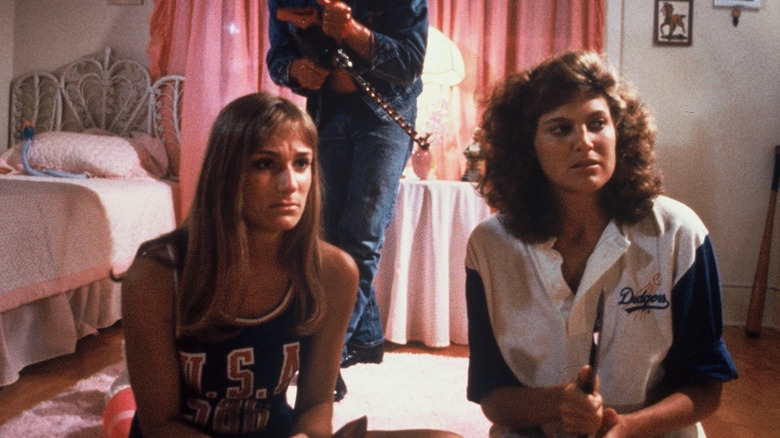
This deceptively feminist slasher from director Amy Holden Jones is such a deft satire that many viewers don't even pick up on the commentary, reading it instead as an earnest exploitation film. With her parents out of town, high school student Trish Deveraux (Michelle Michaels) decides to throw a slumber party for her best girlfriends. It's a night of pizza, pajamas, gossip, and a few boys who show up hoping for a peek into the festivities through their window. Also watching from the outside is new student Valerie (Robin Stille) who rejects an invitation after Trish's friends were rude to her. However, the party is interrupted by Russ Thorn (Michael Villella), an escaped serial killer with an affinity for power tools. Also known as the Driller Killer, Thorn stalks and kills the girls one by one per the typical slasher formula.
Thorn is a formidable killer and his weapon is as deadly as any. What makes "The Slumber Party Massacre" so survivable is its phenomenal cast of women. The male characters are ineffectual at best and lecherous at worst, but the women here are resourceful, courageous, and strong. During the empowering climax, several of the girls fight off the killer before Trish and Valerie work in tandem to take him out once and for all. This is how the average person would likely survive the film. It won't be easy, and it will definitely be dangerous, but if we work together, we can defend ourselves against any enemy.
House Of Wax (2005)
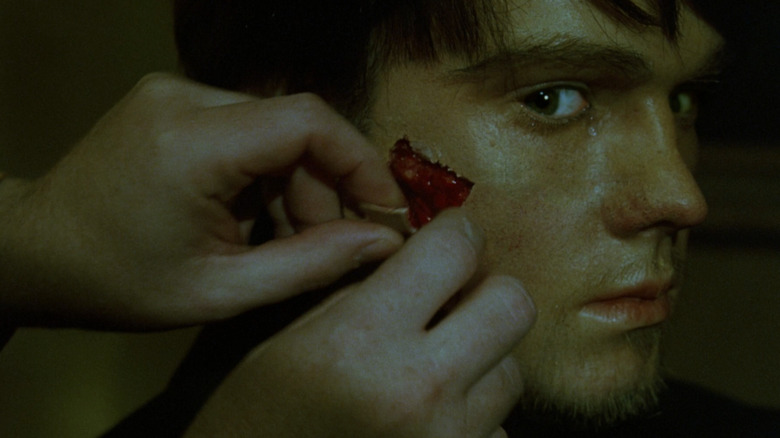
The 2005 remake of the 1953 film "House of Wax" (which in turn is a remake of 1933's "Mystery of the Wax Museum), is one of the better entries in the wave of horror remakes that proliferated the mid to late aughts. Aside from the distasteful "see Paris die" marketing campaign, the film is surprisingly fun. It's a mean and brutal cross between torture porn and teen slasher, with one of the most upsetting kills in horror movie history. Wade, played by CW darling Jared Padalecki, is turned into a living wax sculpture in an excruciating scene that still packs a punch. Wade doesn't do himself any favors in this movie, and though we never want to blame a character for their fate, this painfully prolonged death is entirely avoidable.
At least three times, Wade enters a house or business uninvited, even going so far as to walk into the infamous House of Wax when the door clearly says the museum is closed. When using the restroom in the killer's house, he goes wandering through the home, nosing about in their private rooms, and it's at this moment that he's subdued with an injury to his Achilles tendon that you can practically feel while watching. Should the average viewer fall into the clutches of devious wax artists Bo and Vincent, they would likely wind up in one of the town's wax tableaus. Hopefully, they would have a little more respect for physical boundaries and not go barging into dangerous places where they don't belong.
Trick 'R Treat

Michael Dougherty's anthology film, "Trick 'r Treat," is a seasonal delight and has gone on to become an essential part of any October watch list. Four different stories weave together on Halloween night in a small Ohio town as people celebrate the evening. Anna Paquin leads a group of friends (wearing seductive Disney princess costumes), looking for men to bring to their deadly surprise party. A group of tweens decides to play a terrible prank at the town's haunted quarry. A principal attempts to carve a jack-o'-lantern with his son, and a reclusive curmudgeon learns the true meaning of Halloween. These stories are all connected by an adorable little creature known as Sam. Wearing orange footie pajamas and a burlap sack to hide his face, the tiny Halloween spirit follows each of the groups through the town, keeping watch and protecting the spirit of the season.
Sam's rules are simple: Make sure to hand out candy and never blow out the jack-o'-lantern before midnight. One character finds this out the hard way when she's brutally punished for her overzealous need to clean. Blowing out her pumpkin's candle early in the evening seals her fate and she becomes one of her own lawn decorations. However, "Trick 'R Treat" has a mean streak of morality, and there's another unspoken rule: Be kind to others. Aside from a few unsuspecting men who fall victim to their libidos, the characters who harm, bully, or mock others meet horrifying ends, while for the most part, the virtuous characters greet the dawn on November 1st unharmed. So aside from respecting the rules of Halloween, surviving "Trick 'R Treat" seems relatively simple: Just don't be a jerk.
Fright Night (1985)

One of the most beloved horror movies of the 1980s is the horror comedy "Fright Night." A send-up of both vampire lore and horror host culture, it's a surprisingly progressive film that empathizes with all of its characters, even if they're blood-sucking monsters. A vampire named Jerry Dandridge (Chris Sarandon) moves into the crumbling mansion next door to Charlie Brewster (William Ragsdale), a suburban teen obsessed with late-night horror TV and trying to sleep with his girlfriend Amy (Amanda Bearse). While watching movies one night, he sees his two new neighbors carrying what looks like a coffin into their basement. When he spies Jerry seducing a woman who later turns up missing, Charlie begins to suspect his new neighbor just might be a vampire.
Hoping not to blow his cover, Jerry offers Charlie a choice. If he looks the other way, Jerry will leave him alone. Though he threatens Amy and Charlie's mother, this does seem to be a legitimate offer. Chris Sarandon plays the character with such magnetic empathy and confidence that it is easy to believe that he would honor the terms of this deal. Of course, that would leave Charlie to watch him murder woman after woman for however long it takes to blow through his "food" supply and move on. The ethics of how this choice affects others is a question for another day, but the fact remains that any of us could likely survive this film by accepting Jerry's deal, putting away the binoculars, and minding our own business.
Scream (1996)
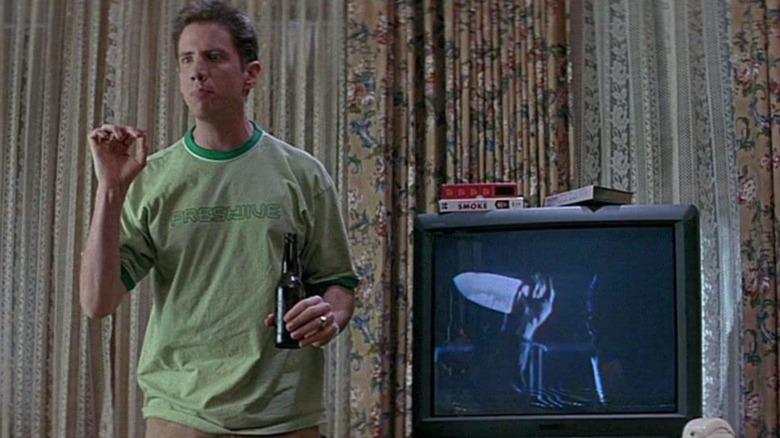
Sidney Prescott (Neve Campbell) is a high school student still reeling from the brutal murder of her mother when her classmates start dying. Soon, she receives calls from a mysterious voice wanting to know her favorite scary movie. Wes Craven's genre-busting masterpiece is the rare film that manages to serve as a love letter to the subgenre it's dissecting while functioning as a terrifying film in its own right. It's this analysis of the classic slasher formula that makes "Scream" survivable. In the movie's final set piece, film geek Randy delivers a drunken dissertation on how to survive a horror movie. Loosely based on Carol Clover's classic slasher formula in "Men, Women, and Chainsaws," his advice is relatively simple: Don't have sex. Don't drink or do drugs. And never, ever say, "I'll be right back." Though following these rules doesn't guarantee safety, it would give the average person a leg up on the mask wearing killer.
"Scream" is also notable for focusing on its survivors. Rather than a killer who goes on to become a monstrous sort of anti-hero, Sidney is the heart and soul of the franchise. The Ghostface mask may be the same, but it's always a different person (or two) underneath it, and these fallible killers are all too human. Sidney fights off the killers time and again, constantly refusing to be a victim. It's her inspiring example that makes surviving in the "Scream" universe entirely possible.
The Texas Chain Saw Massacre (1974)

Another film that changed the face of horror is Tobe Hooper's macabre masterpiece "The Texas Chain Saw Massacre." Setting the template for horror films to come, a group of five friends set out on a road trip and happen to run afoul of Leatherface (Gunnar Hansen) and his depraved family of cannibals. Looking for a swimming hole while visiting their friend Sally Hardesty's former family homestead after running low on gas, Kirk (William Vail) and Pam (Teri McMinn) stumble upon a mysterious house. The door is unlocked and Kirk walks in only to find a gigantic butcher wearing a mask of human skin. Leatherface and his family have lost their jobs with the closing of the local slaughterhouse and have survived by cooking and selling human flesh as barbeque. Many argue that a creepy hitchhiker (Edwin Neal), who turns out to be Leatherface's brother, marks the group's van designating them as the next victims, but the fact remains that Leatherface does not seek the friends out. They wander onto his turf and must pay a steep price.
While this film could perhaps be survived by simply not wandering into strange houses, the group is forced to go begging because of a more simple problem: they've run out of gas. Many interpret "The Texas Chain Saw Massacre" as a commentary on economic inequality and this setback is one many viewers encountered during this period. Once in the clutches of Leatherface and his depraved family, the odds of survival drop to nearly zero, but avoiding them should be relatively easy. With simple empathy and understanding of the rural community they're visiting, not to mention a spare reserve of gas, the average person should be able to drive through Letherface's Texas territory unscathed.
Candyman (1992)

A twist on the classic Bloody Mary invocation, Bernard Rose's adaptation of Clive Barker's "The Forbidden" has become a genre classic and conversation starter that examines race, privilege, and poverty. It also turned its honey-voiced star, Tony Todd, into a beloved figure in the horror genre. Once a painter who died a horrible death at the hands of a racist mob, Candyman is a hook-handed specter haunting Chicago's infamous Cabrini-Green housing project. When graduate student Helen Lyle (Virginia Madsen) infiltrates this world hoping to study the urban legend, she invokes the monster, and he chooses her to be his next victim, keeping his powerful tale alive.
Candyman is at once a terrifying murderer and an empathetic sort of anti-hero for a forgotten community. His rules are relatively simple: If you say his name five times in the mirror, then turn off the light, he will appear behind you and kill you with his hook. Not taking the legend seriously, Helen performs this ritual in her bathroom but doesn't turn off the light leaving us to wonder if the curse could be defeated simply by keeping the light on. However, the larger method of survival remains. Simply not invoking the legend will serve as protection. Unlike Helen, we can avoid our fate by refusing to treat those different from us as exhibits to satiate our curiosity. The best weapon against Candyman is a reverence for his contagious power and respect for the community in which he resides. Nia DaCosta's inspired 2021 sequel, "Candyman," examines the very meaning of the word survival by positing that through fear, awe, and power, Candyman's legacy survives well past his horrendous death.
The Witch

Robert Eggers's meticulous "The Witch" is a terrifying folk tale and a bleak examination of religion, corruption, and power. Thomasin (Anya Taylor-Joy) is a young Puritan girl who moves with her family into the New England wilderness when her prideful father (Ralph Ineson) rejects the colony that provided them safety. A witch who lives in the nearby forest begins to prey on the family, systematically tearing them apart while turning them against each other. As a young woman in a rigidly patriarchal world, Thomasin is blamed for everything the witch does, and her family eventually accuses her of being the witch herself. With her family dead and nothing left to lose, Thomasin reaches out to Black Phillip, the family's unruly goat who is rumored to be a conduit for the devil. She accepts his offer to "live deliciously" and follows him into the woods where she joins a coven of witches and ascends into the midnight sky.
Interpretation of this divisive ending depends heavily on the perspective of the viewer. If Black Phillip is the monster, Thomasin is doomed to become what she most fears, but if the real monster is her family — who would sacrifice her for their own survival — she has succeeded in subverting their oppression. Leaving the religious aspects of her choice aside, most of us could survive this New England folk tale by rejecting the pride that drove Thomasin's father to leave the safety of the colony in the first place. Yet, if we were to find ourselves alone in the forest, all survival would require is a willingness to expand our ideas of what good and evil actually mean.
Signs

M. Night Shyamalan's "Signs" is known for many things. This sci-fi horror film depicts a worldwide alien invasion told from the quiet perspective of a Pennsylvania family struggling to recover from the loss of their mother. For many, it signals the end of an era: the last film before the bubble burst on Shyamalan's hot streak and the last major film role for its lead Mel Gibson before the DUI arrest that would lead to his public downfall. With this infamous reputation and the film's slightly unbelievable twist (we'll get to that soon), it's easy to forget just how good "Signs" is. There are moments of pure terror, sorrow, and mystery. And the scene showing news footage of the first confirmed alien sighting packs just as much of a punch today as it did upon release.
Beginning with his breakout hit, "The Sixth Sense," Shyamalan developed a reputation for shocking twists, and the conclusion to "Signs" is the moment when this trend began to feel contrived. The aliens that pose a deadly threat to humanity can be gravely wounded by water, and Earth just so happens to have that in abundance. The reason an alien race would come to a planet filled with the one thing that can kill them is a question for another day, but the fact remains that, though the aliens are terrifying, they are completely survivable. Arm yourself with a super soaker, a bottle of Dasani, or even a Solo cup filled with tap water, and the average person will be just fine.
If you or a loved one has experienced a hate crime, contact the VictimConnect Hotline by phone at 1-855-4-VICTIM or by chat for more information or assistance in locating services to help. If you or a loved one are in immediate danger, call 911.
Interview With The Vampire: The Vampire Chronicles

Ann Rice's "The Vampire Chronicles" rejuvenated the vampire sub-genre with fresh lore and lush sensuality. The most well-known entry is "Interview With the Vampire," the story of an 18th-century New Orleans man named Louis de Pointe du Lac (Brad Pitt) and his transformation into an immortal creature of the night. He tells this story to Daniel Molloy (Christian Slater), an interviewer who is shocked to learn midway through their conversation that the story is true. Louis is reluctant to feed on humans. Finding the practice immoral, he subsists on rats and animals for as long as possible before his overwhelming thirst takes over. This is in sharp contrast to his companion and creator, Lestat de Lioncourt (Tom Cruise), who delights in his nightly bloodlust and debauchery. Finally tired of Lestat, Louis and their adopted daughter, Claudia (Kirsten Dunst), attempt to kill him and flee to Europe. Seeking revenge for the betrayal, Lestat offers Molloy the same vampiric choice he once gave Louis.
While Louis is a deadly monster, he does not kill for pleasure the way Lestat does. He only kills to eat and tries to avoid causing harm to others whenever possible. Louis does not wish to hurt Molloy, only to tell his story. Surviving him is easy: Simply promise to listen, and make sure he's recently fed. Surviving Lestat, on the other hand, might be a little trickier. You'd just have to hope he's in the mood for companionship — and make sure to check your back seat.
Poltergeist (1982)
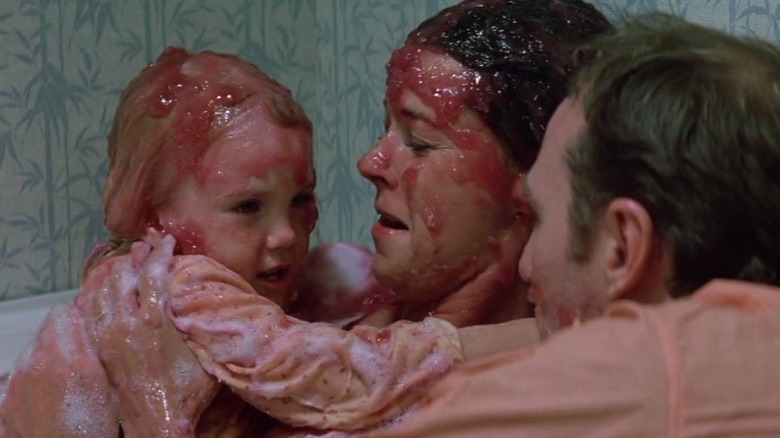
Surviving Tobe Hooper's "Poltergeist" might be tricky, but with a willingness to relocate and perhaps get a little goopy, the average person should be able to escape this 1982 classic unscathed. Steve (Craig T. Nelson) and Diane Freeling (JoBeth Williams) are living the American dream. They have a beautiful home, three happy children, and a mischievous dog, but this tale of corruption in suburbia is every homeowner's worst nightmare. When youngest daughter Carol Anne (Heather O'Rourke) goes missing during a thunderstorm, the Freelings realize there's more than meets the eye when it comes to their perfect family home. Having been built on top of a cemetery (Steve's corner-cutting company only moved the headstones), their home is a portal between this world and the next, haunted by the spirits of the bodies they have disturbed.
Though extremely scary, "Poltergeist" is rated PG and served as one of the catalysts for the creation of the PG-13 designation. Given this lower rating and the fact that no one dies in the film, surviving "Poltergeist" is possible. Paranormal activity in the house is fairly predictable, and the Freelings live in the house for some time after Carol Anne disappears. They enlist the help of Tangina (Zelda Rubinstein), a powerful medium who guides them in retrieving the child from the other realm. Heroic mother Diane Freeling ventures into the abyss to retrieve her daughter, and they both make it out safely. It seems all they need is a few tennis balls, a rope, and a heavy dose of courage.
Cube
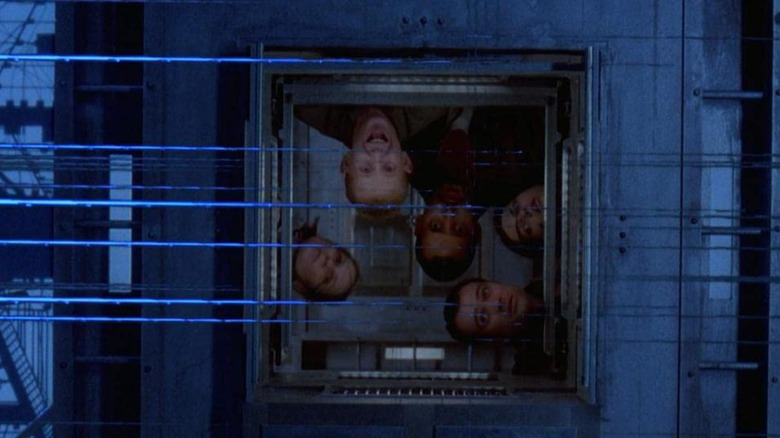
Of all the films on this list, "Cube" would probably be the most difficult to survive, but it is possible because the titular prison is based on logic. In Vincenzo Natali's 1997 indie, six strangers wake up in separate cells of a cubic maze. Each room has hatch-like portals on the ceiling, floor, and each of the four walls. Some of these hatches are innocuous doorways into the next room, but some are deadly booby traps that activate poison gas, flame-throwers, acid, spikes, or the '90s' favorite method of movie murder, a grid of wires capable of cutting a human body into tiny pieces. Combine this with a lack of food, a seemingly endless string of rooms, and the unpredictable people you happen to be stuck with, and surviving "Cube" becomes an uphill battle.
However, the Cube is a logic-driven system, making it possible to predict and survive. The survivors eventually notice a set of numbers on each hatch and realize that only those containing prime numbers trigger booby traps. They also deduce that the rooms are moving according to these numbers, which also serve as coordinates, and race to find the room that serves as a bridge to the structure's outer shell. Once they get there, they realize it's the room in which they started their journey. Combining these variables, it's clear that all you need to survive "Cube" is a facility for advanced math and the patience to wait until you're presented with an opening.
Gremlins

Perhaps an obvious entry on this list, "Gremlins" is a movie all of us should be able to survive. Inventor Rand Peltzer (Hoyt Axton) buys an unusual Christmas gift for his son Billy (Zach Galligan), an adorable Mogwai named Gizmo. The charming little creature comes with three simple rules: Don't expose him to sunlight, don't get him wet, and never, ever feed him after midnight. Failing to impress upon Billy the importance of these rules, Rand simply passes the animal on and heads out of town. When Gizmo inevitably gets wet, his coat spawns a new batch of Mogwais. The leader, Stripe, is a mischievous creature with a taste for destruction. The new batch sneaks food after midnight and transforms into the lizard-like gremlins who first destroy Billy's house and then wreak havoc on the town.
The gremlins are relatively easy to kill. Simply exposing them to sunlight should do the trick, but they cause an unbelievable amount of damage in a short amount of time. And they are dangerous, sabotaging machinery that leads to several deaths. When Stripe makes his way to the local pool, he multiplies exponentially, flooding the town with these devilish little monsters. Gizmo and Billy are eventually able to defeat the nefarious Stripe and put an end to the madness, but most viewers would be able to survive this movie by just following Gizmo's rules to begin with.
Flatliners (1990)

Joel Schumacher's psychological horror film, "Flatliners," is the most survivable film on this list simply because the harm suffered by each character is entirely self-inflicted. Five medical students, Nelson (Kiefer Sutherland), David (Kevin Bacon), Rachel (Julia Roberts), Joe (William Baldwin), and Randy (Oliver Platt), embark on an experiment to see what lies beyond the boundaries of death. To do this, they each medically kill themselves, allowing each other to flatline while the rest of the team waits to resuscitate them at an agreed-upon time. Early attempts are successful, and they begin to stretch the parameters of the experiment. However, it seems they've brought something back with them. The guilt and shame from the sins of their past haunt them, manifesting in the real world as vengeful spirits.
To survive, they must confront their past traumas and forgive themselves. David tracks down a former classmate he bullied. Rachel confronts the ghost of her father and admits to herself that his death was not her fault. Joe faces consequences for his predatory womanizing, and Nelson finally forgives himself for a tragic childhood mistake. Randy has the good sense never to flatline, the best way to survive the film, but the metaphor for unresolved trauma is one many of us can relate to. "Flatliners" inspires us to forgive ourselves for the sins of our pasts. Our inner demons can sometimes feel like the scariest monsters of all, but the good news is that we can find the courage to forgive ourselves. We just have to be willing to try.
If you or anyone you know is having suicidal thoughts, please call the National Suicide Prevention Lifeline by dialing 988 or by calling 1-800-273-TALK (8255).
Zombieland

Ruben Fleischer's horror comedy is a bit of a stretch for this list because its characters have already survived a zombie apocalypse that decimated most of the world. Columbus (Jesse Eisenberg) is a college student trying to get back to his hometown. To survive, he's developed a system of unflinching rules like maintaining your cardio and always killing zombies with a double tap to make sure they're really dead. Along the way, he meets fellow survivors Tallahassee (Woody Harrelson), Wichita (Emma Stone), and Little Rock (Abigail Breslin), and the new surrogate family heads to Los Angeles. There, they find actor Bill Murray (playing himself), who has developed his own method of survival. He roams the streets disguised as a zombie, allowing him to hide in plain sight. Given all these strategies, surviving "Zombieland" seems easier than ever.
But that's not really what the film is about. Despite its deadly premise, "Zombieland" doesn't just show us the mechanics of survival, it dares us to examine what the word actually means. What good is making it through life if there's nothing left to live for? Each of the characters is searching for a piece of their former existence. Tallahassee desperately wants to find a Twinkie before they all expire, Wichita and Little Rock want to visit a theme park rumored to be zombie-free, and Columbus wants to reunite with his parents. In a deserted world that's gone to ruin, they learn that truly surviving "Zombieland" means finding a way to hold onto their humanity.
Creep

Described as a cross between "What About Bob" and "Fatal Attraction," "Creep" is an intensely unsettling nightmare that demonstrates the dangers of ignoring your intuition. Josef (Mark Duplass) is an eccentric man dying of cancer who hires videographer Aaron (Patrick Brice) to follow him around and make a tape for his unborn son — or at least that's what he claims. As the story unfolds, we begin to suspect that nothing about Josef is what it seems. He initially comes across as a socially awkward clinger who desperately needs a friend, but his intentions grow darker the closer he gets to his victim. Aaron constantly ignores his better judgment to avoid hurting Josef's feelings, and Josef intentionally challenges every social norm imaginable, trying to see how much awkwardness Aaron can stand.
Aaron does eventually escape but finds himself the victim of a stalker. Josef has found his address and sends him creepy presents with overly familiar messages about the strength of their friendship. Aaron finally gets a seemingly earnest apology and agrees to meet Josef at a lakeside park where he meets a shocking end. In the film's brilliant sequel, Josef (now calling himself Aaron) explains to his next would-be victim that he gave Aaron chance after chance to reject him, but he wanted to see himself as a good guy above all else. Josef may have been planning to kill Aaron no matter what, but "Creep" is a testament to the importance of setting personal boundaries and listening to that voice inside our heads that tells us something is off. People-pleasing is a hard habit to break, but hopefully, most of us would survive by listening to our intuition and leaving when someone repeatedly and intentionally makes us uncomfortable.
1408
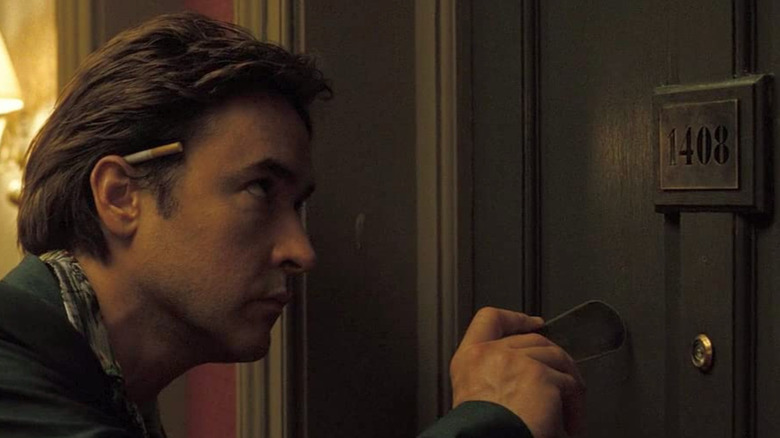
In this harrowing adaptation of Stephen King's short story, paranormal nonfiction writer Mike Enslin (John Cusack) books a night in 1408 while working on a book about haunted hotel rooms. Hoping to stop him is the hotel's manager Gerald Olin (Samuel L. Jackson) who makes a case for the room's deadly power. Olin presents Mike with a shocking history of accidental deaths, murders, and suicides that have all occurred within the confines of 1408. Not to be deterred, Mike insists on his stay in the room, even though Olin predicts he will not make it out alive. Olin offers basketball tickets, expensive bourbon, and an upgrade to the nicest room in the house — anything to keep him out of the room with a body count of 56 and counting.
Understanding that Mike feels compelled to stay because of his book, Olin offers him a chance to stay in an identical room. His readers will never know the difference. Still, Enslin will not be deterred. Bolstered by a combative spirit and a refusal to believe in any kind of life beyond the grave, he refuses to believe that anything in the room can harm him, an assumption that proves to be spectacularly incorrect. We would all likely perish in room 1408. Mike is forced to essentially set himself on fire to escape. It's probably a safe assumption that, given Olin's full-throated warning and a sweetheart deal to fake our stay, most of us would survive "1408" by never setting foot in the haunted room at all.
The Babadook
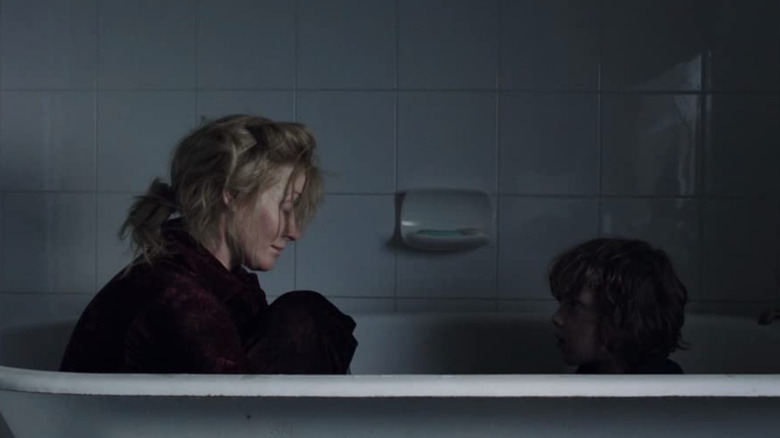
This beautiful Australian film is both a terrifying ghost story and a moving depiction of grief, depression, and loneliness. Amelia (Essie Davis) is a single mother to young Samuel (Noah Wiseman), a troubled child whose father was killed in a car crash on the day of his birth. When a mysterious book appears on Samuel's shelf, Amelia reads the sinister bedtime story and unintentionally invites in a terrifying monster known as the Babadook. This inky black creature torments them both, eventually possessing Amelia and luring her towards the unthinkable in an attempt to rid herself of her massive emotional burden.
This brilliant film is a metaphor for mental illness and unresolved grief. Amelia must constantly fight back against the Babadook as she struggles to connect with her son and face the pain she's tried so hard to forget. Though some quibble with the ending, it's a moving depiction of therapy as Amelia finally expels the Babadook, but keeps it in the basement of her house. Each day she goes downstairs to feed it, facing her trauma in small doses. She then emerges to carry on with the rest of her life. Though the road is hard and the territory is frightening, Amelia ultimately survives by opening up and accepting the support that's been there all along. Survival is possible for her and all of us as well. The most terrifying battle of all is often the one we have in our own minds. Sometimes the bravest and most powerful thing we can do is face our inner demons and find the courage to carry on.
If you or someone you know needs help with mental health, please contact the Crisis Text Line by texting HOME to 741741, call the National Alliance on Mental Illness helpline at 1-800-950-NAMI (6264), or visit the National Institute of Mental Health website.
Read this next: Horror Movies That Even Horror Fans Could Hardly Finish
The post 20 Horror Movies Most People Could Actually Survive appeared first on /Film.
